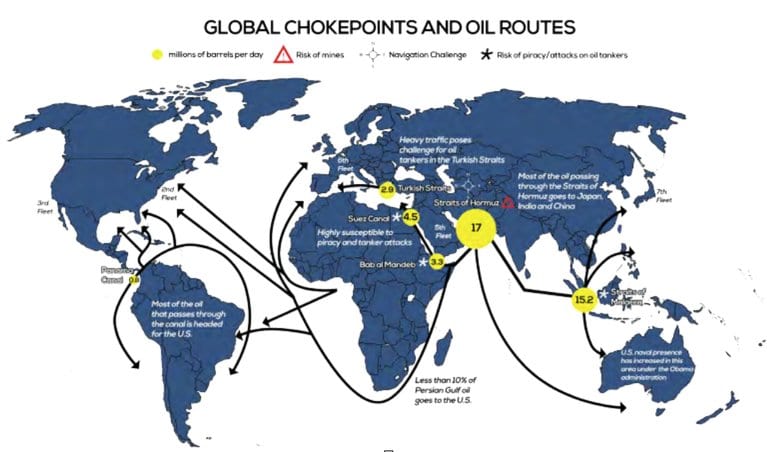The recent reports of an Al Qaeda threat to disrupt Australian fuel supplies is fuel for thoughtful action on an issue of national importance. International press reported on the weekend that this Al Qaeda-published map or plan showed the way to ‘choke’ Western economies. (Al Qaeda Resurgence Magazine, p.96, reproduced in Business Insider, Australia, 1 Nov)
Australia currently imports 91% of its petrol and diesel, already refined overseas, and has been closing its refineries. Over 50% of Australia’s fuel comes by ship from a single refinery in Singapore, thus offering a significant threat to national security.
The NRMA has expressed concern that Australia has only 14-20 days’ fuel supply on shore in Australia (plus 3 days in cars’ petrol tanks, on average), in contrast with Europe which has between 90 and 200 days’ supply, Japan which has 171 days and Korea which has 222 days’ supply (2013 figures).
Former deputy chief of the Airforce, Air Vice-Marshall John Blackburn, says that any interruption to fuel supply would be “catastrophic” with food and pharmaceuticals running short within 3 to 4 days. Some businesses would close and would not re-open.
Reliance on fuel from a couple of vulnerable sources is clearly risky. Diversification of fuel supply would appear to be in the national interest to increase resilience. The NRMA also reports that Australia is in breach of its requirement to hold at least 90 days’ supply of fuel but government appears content to let business and the market manage the problem.
While short-term action is needed to address this specific threat, a medium term perspective should include diversification of energy sources for transport. Electric vehicles (EVs) and plug-in hybrids (PHEVs) offer the potential for replacement of dependence on imported fuels with the independence and resilience of domestic electricity. This extra electricity can be generated from the grid via fossil fuels or renewables (wind), from local PV or ubiquitous GreenPower.
A side benefit is the reduction of emissions from transport – 12% of Australia’s emissions are from passenger and light commercial transport. The Electricity Supply Association of Australia points to the strategic benefits of EVs/PHEVs through scaled-up demand, especially at off-peak, improved grid utilization and reduced exposure to oil price vulnerability. Renewables can be net suppliers if the right policy is put in place.
Australia is currently bereft of policy to increase the adoption of EVs and PHEVs. Europe, China and the US all have strong policies which are achieving significant penetration (up to 14% of all new sales in some countries). Some of these policies use various subsidies as an incentive but some of the more successful policies are cost-neutral. Policy is often enacted at international, national, provincial/state and local government level. For example, the city of Indianapolis in the US has a policy to switch its entire fleet of essential services and other government vehicles from gasoline and diesel to EV/PHEV by 2025, starting with 425 police vehicles. Other US states are cooperating in a variety of ways to fine-tune existing regulations and policy. The EU has a policy relating to transport emissions which is arguably driving manufacturers to offer PHEVs/EVs right across their model ranges e.g. Audi’s commitment to do so by 2020. (They launch their A3 e-Tron PHEV in Australia this week).
EVs and PHEVs can provide diversification of fuel supply, improved resilience, reduced economic risk, reduced greenhouse gas emissions and reduced pollution. But decisive and cost-neutral or cost-effective policy at all levels of government is required to make it happen.











